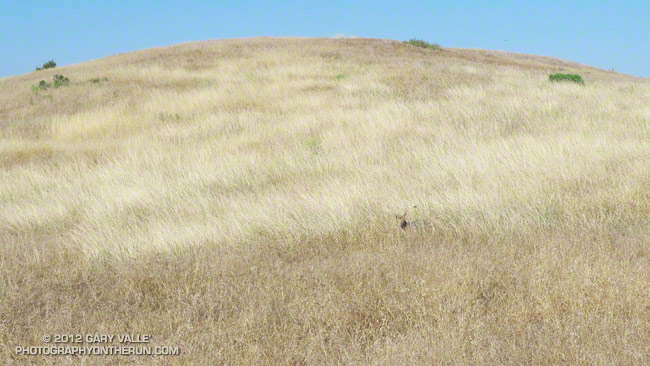
A comfortably camouflaged coyote watches me run past.
From a run in mid June on Lasky Mesa in Upper Las Virgenes Canyon Open Space Preserve (Ahmanson Ranch).

A comfortably camouflaged coyote watches me run past.
From a run in mid June on Lasky Mesa in Upper Las Virgenes Canyon Open Space Preserve (Ahmanson Ranch).
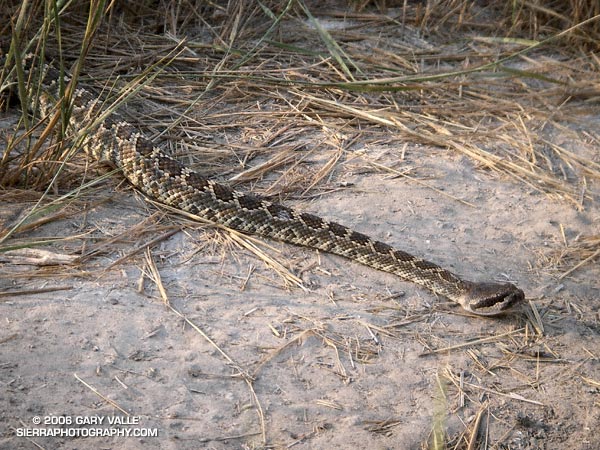
A Southern Pacific Rattlesnake (Crotalus oreganus helleri) at Upper Las Virgenes Canyon Open Space Preserve (formerly Ahmanson Ranch).
The problem with rattlesnakes is that they can be notoriously difficult to see — especially when they are lurking in the shade on a narrow section of brushy trail and you’re wearing sunglasses.
Related post: Big Southern Pacific Rattlesnake at Ahmanson Ranch
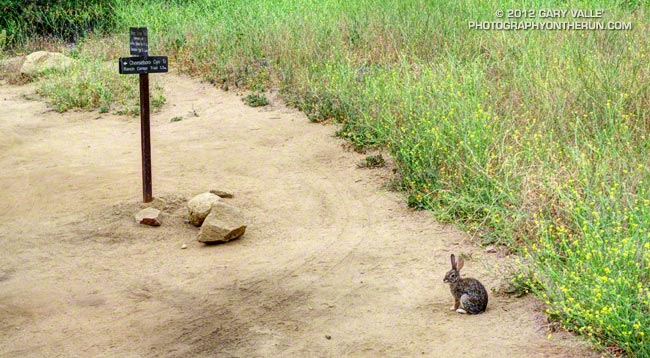
I don’t think I’ve ever seen as many rabbits on a run. It seemed that every few strides another rabbit, or two or three rabbits, would pop up on the trail.
Cottontails have a peculiar behavior when people approach. When one sees me running toward it, it will often watch and wait…, watch and wait… It’s almost like the rabbit is waiting to see just how close I’ll approach. Usually when I’m about 10-12 feet away — sometimes closer — it will break for an established escape path. Then just a foot or two into the brush, it will stop again. If you stop and stand very still, many times a rabbit “on pause” will just sit there, 3 to 4 feet away.
Rabbits aren’t always so calm. One time I was running down Las Virgenes Canyon and a ground squirrel and rabbit were on the road about 25 yards ahead of me. They must have been preoccupied with each other because when the squirrel finally noticed me, it panicked and bolted toward the rabbit. That caused the rabbit to freak. The rabbit launched like a rocket, just as the squirrel collided with it. The resulting visual was of a rabbit eight feet in the air with a ground squirrel spinning off-kilter below it!
From this morning’s Cheeseboro Canyon Loop from the Victory Trailhead of Ahmanson Ranch (Upper Las Virgenes Canyon Open Space Preserve).
Related post: Classic Cheeseboro Canyon
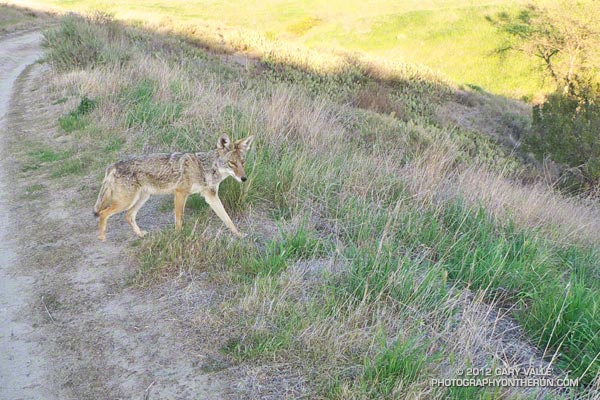
Last June I had an unusual encounter with a coyote near the end of a run at Ahmanson Ranch (Upper Las Virgenes Canyon Open Space Preserve). For reasons known only to the coyote, the animal behaved like a dog and ran with me a short distance along a dirt road. Not off to the side of the road, or at a distance, but as if on lead and out for a daily jaunt. Today, on the same section of road, I had another odd encounter with a coyote.
This time I rounded a corner to see a coyote calmly trotting down the middle of the dirt road toward me. No big deal, it would do what a coyote normally does — see me and head for the brush. Except it didn’t. This time it continued to trot in my direction. Fifty, thirty, twenty feet — the gap between us closed. Watching each other intently, we stopped about 12 feet apart.
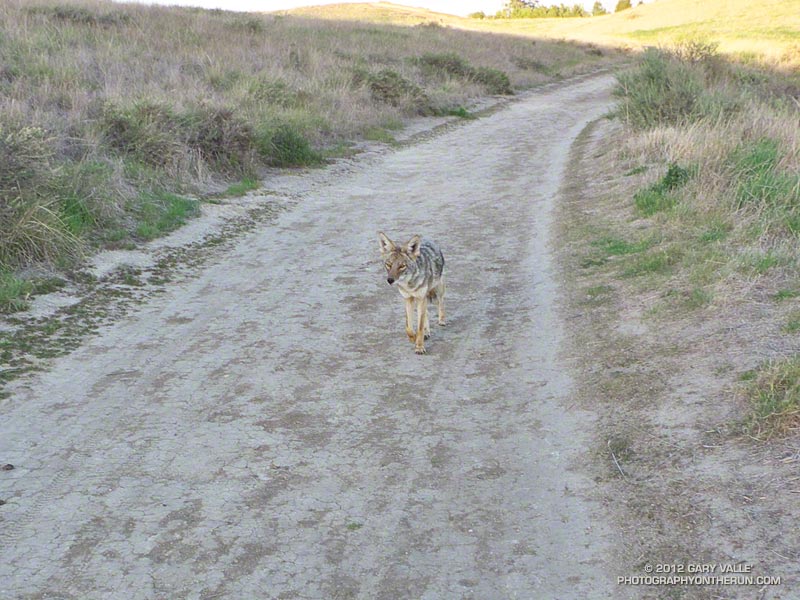
For a few moments we stared at each other, my expression no doubt showing the same mix of wariness and curiosity as the coyote’s. In the practiced motion of something wild, the coyote briefly raised its head, sampling scents of its world on the wind. I edged closer — not daring to raise my camera, but taking the occasional photo.
A few more seconds passed, then apparently deciding enough was enough, the animal sauntered into the grass.
Coyotes are opportunists and I’m guessing these close encounters are related to an association of people with food — perhaps discarded food or food intentionally provided. Coyotes also associate people with their pets. Recently I saw a pair of coyotes behaving oddly (also at Ahmanson) and nearby an individual was walking their small dog off lead.
Some related posts: Coyote Tag, Trickster
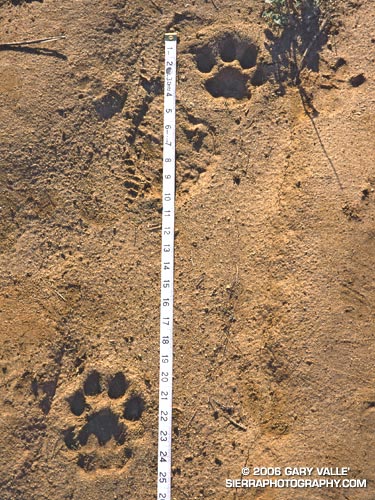
Originally posted November 25, 2006. Updated November 11, 2020.
Nature isn’t necessarily nice. Behavior and interactions among animals are often violent. So it is with mountain lions. But the mountain lions of the Santa Monica Mountains also have to cope with the additional problems of living on an island of lion habitat in the middle of an ocean of urban sprawl.
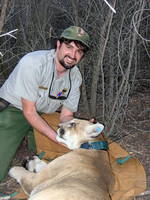
The mountain lion tracks above were photographed on a run at Sage Ranch Park in late January 2000. They might have been made by a young male mountain lion designated P3, whose territory encompassed this area. There is also a possibility there were from an older female lion, P4 that frequented the Rocky Peak area. Unfortunately, both these animals were killed in late 2004 by eating prey (coyote) that had eaten rodents that had consumed anticoagulant-based poisons. These poisons are used by parks, schools, golf courses, and housing developments for rodent control.
The P3 and P4 pumas were tracked as part of an ongoing study started by the National Park Service in 2002 to learn more about mountain lions in the Santa Monica Mountains National Recreation Area. As of May 2012, twenty-six mountain lions, P1 to P26, have been tracked, and their history has been quite a saga.
The patriarch of the lions in the study is P1. He was the first lion captured and collared in 2002, and at that time was estimated to be 5-6 years old. In his prime, P1 was a large, 140+ lb. male whose territory was essentially all of the Santa Monica Mountains. In August of 2004, P1 and P2 – the only female lion known to be in P1’s range – produced a litter of four cubs — two males (P5 and P8) and two females (P6 and P7).
Despite high hopes for the lions and their new litter, things turned ugly in August of 2005, when P1 killed his mate P2. A few months later, in June of 2006, P1 also killed one of the 22-month-old females from the litter, P7. According to biologists these were not the actions of a lion run amuck but were most likely related to conflicts over kills, or in the case of P2, a mother protecting her offspring.
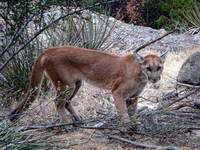
As might be expected, the young males from the litter, P5 and P8, headed for opposite ends of P1’s territory. However, urbanization and limited linkages essentially prevented their escape to other wildland areas.
In early September 2006, P5 was likely killed by P1, and in a development that surprised researchers, P8 appeared to have been killed by an unknown lion, probably male, inside of P1’s territory. The “unknown lion” was the male P9, who was killed by a vehicle on Las Virgenes road in July 2007.
One other female lion was collared and designated P13. DNA testing indicated that P13 was a daughter of P6. At that time P6 was the only surviving lion from P1 and P2’s 2004 litter.
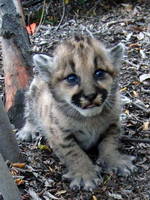
P1 appears to have been injured in a battle for dominance in March 2009. A bloody radio collar and tufts of hair were found in a tree in Hidden Valley, near Thousand Oaks. P1’s opponent was suspected to be P12, a lion collared in December 2008, and the first lion to be tracked crossing the 101 Freeway. Scat found three weeks after the fight was genotyped, and found to be P1’s.
In May 2010 P13 had a litter of three kittens — P17 (female), P18 (male), and P19 (female). The father was P12. Since P12 originated from an area other than the Santa Monica Mountains, this increased the genetic diversity of the mountain lion population in the study. P18 was killed August 30, 2011, attempting to cross the 405 freeway.
It is unclear how many male lions now inhabit P1’s original territory. P12’s collar is no longer functioning. P18 was killed August 30, 2011, attempting to cross the 405 freeway. P15 was found deceased on September 11, 2011. Reportedly another male lion has been photographed in the area.
In May 2010 a male lion living in the Santa Susana Mountains west of I-5 was collared and given the designation P16. This is the first lion to be followed in the Santa Susana Mountains since P3 and P4 died in 2004, after eating contaminated prey. P21, an adult male, is also being tracked in the Santa Susana Mountains. Both P16 and P21 have made excursions into Angeles National Forest, and P16 remains there.
The map above shows the home ranges of mountain lions P10, P12, P13, P14 and P15 in the Santa Monica Mountains, and some monitored locations of P16 in the Santa Susana Mountains. Here is another map that shows the home ranges of the mountain lions P1 to P12 in the Santa Monica Mountains, Simi Hills, and Santa Susana Mountains. It was adapted for the web from this NPS map (PDF), produced in 2009.
The Puma Profiles page of the SMMNRA website lists the mountain lions that have been studied. More information, news releases, maps, and photos can be found on the main NPS Lions in the Santa Monica Mountains? page.
The mountain lion saga continues…
Some related posts: It’s Raining Mountain Lion Tracks!, Mountain Lion Tracks on Rocky Peak Road
Johanna Turner of CougarMagic.com has captured breathtaking stills and videos of the area’s mountain lions and other wildlife.
Following are some previous updates to this post, with links to additional articles and information.
Update October 24, 2012. The remains of P-25, an approximately one-year-old female mountain lion were discovered by hikers in Point Mugu State Park on Sunday. P-25 and P-26 (male) are the offspring of P-12 (male) and P-13. The death did not appear to be the result of a conflict with another lion. A necropsy is pending.
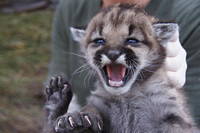
Update October 18, 2012. This summer NPS biologists discovered two mountain lion kittens, P-23 (female) & P-24 (male), east of Circle X Ranch in the Santa Monica Mountains. They are the offspring of P-12 (male) and P-19, a daughter of P-12. The kittens were outfitted with tracking devices.
Update June 18, 2012. Analysis of the DNA of the mountain lion killed by authorities in downtown Santa Monica on May 22 revealed it is related to lions that reside north of the 101 Freeway. One possibility is that the approximately three-year-old lion was the offspring of mountain lion P-12. P-12 has been documented crossing the 101 Freeway in Agoura and is the only lion known to have done so.
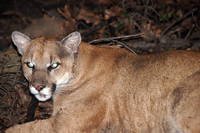
Update May 26, 2012. Earlier this Spring biologists from Santa Monica Mountains National Recreation Area (SMMNRA) captured an adult male mountain lion in the Griffith Park area. Designated P-22, the approximately three-year-old lion is the first to have been photographed east of Cahuenga Pass and within the Santa Monica Mountains eco-region. The lion was fitted with a GPS collar and released where it was captured. According to Kate Kuykendall, Public Affairs Officer for the SMMNRA, preliminary genetic analysis by UCLA indicates that P22 is likely from the Santa Monica Mountains, which would mean he crossed both the 405 and the 101 Freeways.
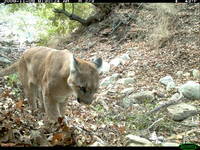
Update November 21, 2011. On October 4, 2011, the National Park Service announced that male mountain lion P-15 has been killed. It was the first documented intentional human-caused death of a mountain lion in the Santa Monica Mountains. P-15’s collar stopped transmitting on August 25, 2011. P-15 was discovered on September 11, 2011, following a report of a dead mountain lion. The California Department of Fish and Game and the National Park Service are seeking information related to the death of P-15 and the parties responsible. With the addition of $5000 from the City of Malibu, the reward being offered for information leading to the arrest and conviction of the poachers currently stands at $16,700. The DFG Cal Tip Hotline is 1-888-334-2258.
Update August 7, 2009. According to Where the Mountain Lions Live in the Santa Monica Mountains in laist.com, P1 may have survived the fight with another mountain lion back in March. DNA from scat collected about two weeks after the fight matched P1!
Update March 28, 2009. There was sad news earlier this month. According to an article in the Daily News, mountain lion P1, the long-standing patriarch of the Santa Monica Mountains, appears to have lost a battle for dominance with another mountain lion. A bloody radio collar and tufts of hair were found in a tree in Hidden Valley, near Thousand Oaks. P1’s opponent is suspected to have been P12, a lion collared in December, and the first lion to be tracked crossing the 101 Freeway.
Update October 6, 2008. The Ventura County Star reported that a young male lion was found dead on October 2 on the 118 freeway, just west of Rocky Peak Road. A wildlife passageway crosses under the freeway nearby and has been used by at least one other lion. On July 18 a mountain lion was reported in the area of the Chumash Trail.
Update May 1, 2008. NPS wildlife biologists are currently aware of 4 lions in the Santa Monica Mountains — 2 recently radio-collared young males designated P10 and P11, and P1 and P6. There is probably at least one more female, the mother of P10 and P11. A remote camera picture has also been taken of a lion in the Simi Hills.
Update January 25, 2008. An article in the Simi Valley Acorn reported that on January 13, 2008, a mountain lion was discovered in an abandoned building near Chatsworth Reservoir. Two days later there was another mountain lion sighting in the nearby Simi Hills by employees at the Santa Susana Field Laboratory.
Update August 7, 2007. According to an article in the Malibu Times, on July 31 a five or six-year-old mountain lion was hit by a car near the tunnel on Malibu Canyon Road and died shortly thereafter. The mountain lion, designated P9, was recently collared, and along with P1 and P6 was one of three mountain lions being tracked by the NPS. There is speculation that P9 may have been the unknown lion that killed P8.
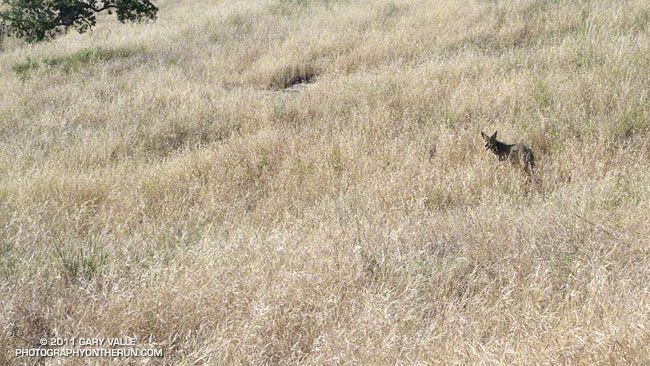
I was deep in thought, but have no idea what those thoughts might have been. It was at that point in a run when miles, and thoughts, flow freely. The afternoon was warm and calm and the settling sun cast a golden hue on the blond, oak-studded hills. My footfalls ticked out a steady rhythm on the dirt road, and my mind was at ease.
My reverie was suddenly broken by the realization that a coyote was running with me. Not running yards in the distance, or in the brush off to the side, but five or six feet in front of me, as if restrained by an invisible lead!
It must have come from the tall grass along the margin of the road, but from my daydream-warped perspective had just suddenly appeared. I’m surprised I didn’t stumble or start. But there was no hint of aggression or malice — just a mischievous glance backward to see how I was going to react.
I didn’t. I’ve had numerous encounters with coyotes, but this went so far beyond my other experiences, I didn’t know how to react.
For more than 50 yards the coyote ran with me, keeping pace in lead along the deserted dirt road.
At some point I started to try and retrieve my camera from the small pack on my waist. The out of synch movement disturbed the delicate balance of this improbable scene, and I could see the change in the animal’s demeanor.
Before disappearing into the cover, the coyote looked back a final time, and in so many words seemed to be saying “gotcha, you’re it!”
(From a run Tuesday at Ahmanson Ranch, now Upper Las Virgenes Canyon Open Space Preserve.)
Some related posts:
– Trickster
– Coyote Tag II